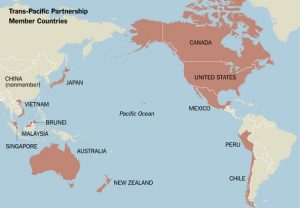
On Monday, January 23, President Donald Trump signed the executive order to withdraw the United States from the Trans-Pacific Partnership (TPP), reported CNN. With this act, he has started to fulfill his campaign promises “to undo America’s trade ties”. “Great thing for the American worker, what we just did,” Trump told reporters as he signed the order.
What is the impact of this step?
A massive trade deal uniting 12 nations and encompassing 40% the world’s economy, TPP would have been the largest regional trade agreement in history. It was negotiated under former President Barack Obama and intended to strengthen relationship of the United States with its regional allies: Japan, Singapore, Vietnam, Malaysia, Brunei, Australia, New Zealand, Canada, Mexico, Peru and Chile – and to counter China’s growing influence on the global trade.
The TPP set the rules on economics, labour and environment around the Asia Pacific region, particularly it lowered tariffs on a range of products, facilitated customs procedures for express shipments, prohibited application of customs duties to electronic transmissions, which would be particularly beneficial to small businesses. Besides, it established an investor-state dispute settlement mechanism to protect investors in foreign countries against uncompensated expropriation of property and assuring them the right to transfer capital relating to their investments. Understandably, the TPP caused many disputes. Its supporters claimed that lower trade barriers would open new markets, raise trade volumes and regional economies. Its opponents contended that the TPP would have a negative impact on employment, many jobs in US, Canada, Japan would be lost due to move of production to Vietnam or Malaysia and doubted whether it would really influence trade volumes.
Anyway, the finalized agreement was signed last year, on 4 February 2016 in Auckland, New Zealand, concluding seven years of negotiations. But it had not been ratified by Congress and therefore the US withdrawal will not have an immediate effect on the country’s economic policies, but, as CNN highlights, it does signal a new and very different US outlook on trade under Trump. Labour unions, who had been long concerned about shifting American manufacturing jobs overseas, can now celebrate the withdrawal. But businesses will lose access to potential new markets. Car producers, tech companies, farmers expected the removal of trade barriers preventing them from selling and expanding in Asia.
“This decision will forfeit the opportunity to promote American exports, reduce trade barriers, open new markets, and protect American invention and innovation,” Arizona Senator John McCain said in a statement critical of Trump’s executive action.
And in geopolitical sphere there can now be expected some shifts also. Chinese leaders are intending to take the United States’ place and expand the country’s influence in the region. In his speech at the World Economic Forum in Davos last week, Chinese President Xi Jinping stressed: “We must remain committed to promoting free trade and investment through opening up and say no to protectionism”.
The 11 remaining TPP nations are now expected to regroup. Some of their trade ministers confirm their intention to go forward with the deal, some seek other regional integration initiatives. The withdrawal of the United States can lead to a major rewrite, or an opening for another global superpower to pursue an alternative agreement.
